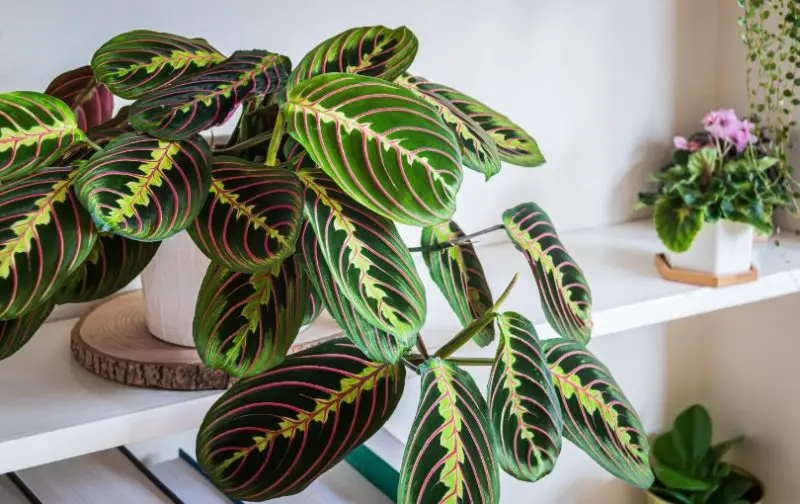The Maranta Prayer Plant (Maranta leuconeura), a beloved tropical houseplant, is admired for its unique foliage and fascinating habit of folding its leaves at night, resembling hands in prayer.
This guide will provide you with the most comprehensive care tips to ensure your Maranta flourishes, enhancing your indoor space with vibrant, exotic greenery.
What is the Maranta Prayer Plant?

The Maranta Prayer Plant is recognized for its broad, decorative leaves that lay flat during the day and fold upward at night, mimicking a praying motion. This striking plant is a slow grower but can reach up to 12 inches in height, making it a perfect addition to indoor spaces.
- Common Name: Prayer Plant
- Botanical Name: Maranta leuconeura
- Family: Marantaceae
- Plant Type: Herbaceous, perennial
- Size: 6–12 inches tall, 6–12 inches wide
- Light: Partial shade to indirect light
- Soil Type: Moist, well-draining, loamy, acidic
- Soil pH: Neutral to acidic
- Bloom Time: Spring
- Flower Color: White
- Hardiness: Zones 11-12 (USDA)
- Native Region: South America
- Toxicity: Non-toxic to pets and humans
Ideal Conditions for Growing Maranta Prayer Plants
Light Requirements for Maranta
The Maranta Prayer Plant thrives in bright to medium indirect sunlight. Direct sunlight can cause leaf burn, leading to brown or faded patches. While it can tolerate low-light conditions, this may cause leggy growth. During winter, when the plant becomes dormant, maintain bright indirect light to promote healthy growth.
Best Soil for Maranta Prayer Plant
For optimal growth, use well-draining, loamy soil with a slightly acidic pH. A basic potting mix works well, but you can create a custom mix:
- 2 parts sphagnum peat moss: Retains moisture without waterlogging.
- 1 part loamy soil: Provides nutrients and stability.
- 1 part perlite or coarse sand: Enhances aeration and drainage.
Good drainage is essential to prevent root rot. Ensure your plant’s pot has drainage holes to avoid waterlogged soil.
Watering Maranta Prayer Plant
Keeping the soil evenly moist is critical for the Maranta. During spring and summer, water it once or twice a week, depending on how quickly the topsoil dries. In fall and winter, reduce watering to once a week. Always let the top inch of soil dry before watering again to prevent root rot.
The Maranta is sensitive to chemicals in tap water, such as chlorine and fluoride. If possible, use filtered or distilled water for the best results.
Temperature and Humidity Preferences
The Maranta Prayer Plant thrives in warm and humid conditions, replicating its native tropical environment. The ideal temperature range is 60°F to 80°F. Avoid placing your plant near cold drafts or heating vents, as extreme temperature fluctuations can shock the plant and cause leaf drop.
Maintaining high humidity levels is essential for the Maranta. Here are a few ways to increase humidity:
- Place the plant in a humid room like the bathroom.
- Use a humidifier nearby.
- Mist the plant regularly with distilled water.
- Place the pot on a tray filled with pebbles and water.
Fertilizing Maranta Prayer Plant
During the growing season (spring through fall), feed your Maranta with a balanced, water-soluble fertilizer diluted to half-strength every two weeks. Reduce fertilizing to once a month in winter. Over-fertilizing can cause salt buildup and damage the plant’s roots, while under-fertilizing will result in slow growth.
Common Issues with Maranta Prayer Plant
Yellow Leaves
If the leaves of your Maranta turn yellow, it could be due to overwatering, underwatering, or too much direct sunlight. Overwatering leads to root rot, while underwatering causes dehydration. Ensure you are maintaining the right watering schedule and check the light exposure to avoid yellowing.
Brown Leaf Edges
Brown leaf edges often indicate low humidity or underwatering. Ensure your plant has enough moisture and increase humidity if necessary. Placing the plant near a humidifier or misting it regularly can help resolve this issue.
Drooping Leaves
Drooping leaves may result from temperature changes, pest infestations, drought, or over-fertilization. If you notice drooping leaves, assess the plant’s environment, ensuring it is not exposed to drafts, extreme temperature shifts, or poor watering practices.
Varieties of Maranta Prayer Plants
The Maranta genus offers several striking varieties, each with unique foliage patterns:
- Red/Tri-Colored Maranta (M. leuconeura var. erythrophylla): This popular variety features green leaves with red veins and light green spots.
- Rabbit’s Tracks Maranta (M. leuconeura var. kerchoveana): Its plain green leaves are adorned with darker, splotchy patches.
- Green Maranta (M. leuconeura var. erythroneura): Similar to the red variety, but with white or lime green veins.
- Black Maranta (M. leuconeura var. massangeana): This variety has a darker background with silvery blotches and white veins.
Pruning and Propagating Maranta Prayer Plant
How to Prune a Maranta Prayer Plant
Although pruning isn’t necessary for the Maranta, it can help maintain its shape and promote bushier growth. Prune during the growing season (spring and summer) to stimulate new growth. Use sterilized, sharp scissors to cut back any long stems or remove damaged leaves.
How to Propagate Maranta Prayer Plant
The easiest way to propagate a Maranta Prayer Plant is by division during repotting:
- Remove the plant from its pot and gently separate the root ball into smaller sections, ensuring each section has roots and stems.
- Repot each section in a shallow container with well-draining soil.
- Water thoroughly and place the new plants in a humid, warm area with indirect light.
Maintain even moisture while the new plants establish themselves.
Pests and Diseases Affecting Maranta Prayer Plant
Like other houseplants, the Maranta Prayer Plant can sometimes attract pests such as spider mites and mealybugs. Regularly inspect the underside of the leaves for signs of infestation. If you spot any, use a natural insecticide like neem oil to treat the plant.
- Spider Mites: Look for tiny webs and yellowing leaves.
- Mealybugs: Watch for white, cottony clusters on the leaves.
Common Problems with Maranta Prayer Plant
Root Rot
Root rot is a serious issue for Marantas and is caused by overwatering or poor drainage. If you notice yellowing leaves or a mushy stem, remove the plant from the pot, trim away the rotting roots, and repot in fresh soil with better drainage.
Fungal Infections
Due to their need for high humidity, Marantas can sometimes develop fungal problems. Avoid getting water on the leaves, especially during the evening, to prevent fungus from taking hold. Good airflow around the plant can also help prevent infections.
Conclusion
With its stunning foliage and fascinating movements, the Maranta Prayer Plant is a beautiful and unique addition to any indoor garden. By providing the right balance of light, water, humidity, and care, you can ensure your Maranta thrives year-round. Follow this detailed guide to avoid common problems and enjoy the lush beauty of this tropical gem for many years to come!






